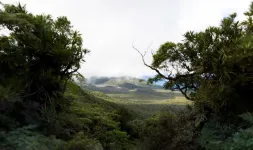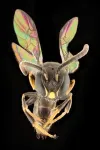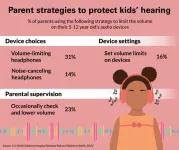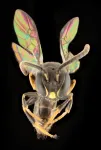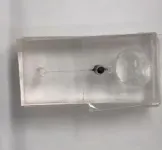(Press-News.org) Eight new Pacific bee species and new insights into Fijian bird behaviour on Viti Levu Island have been described in new scientific studies led by Flinders University.
The studies, both funded by field work supported by the Australian Government’s New Colombo Mobility Plan Program, highlight the potential for species discovery, ecological and conservation knowledge and cultural engagement from Asia-Pacific research collaborations.
In the past 10 years, Australian Government-funded Flinders University field trips have worked closely with the University of the South Pacific, government agencies and other researchers to support important ecology and conservation work in Fiji.
Flinders PhDs Dr James Dorey and Dr Ben Parslow joined researchers from Fiji, Hawaii and Australia to study a totally new group of bees in forest canopies.
“Our investigations have discovered an extra group of endemic bees in Fiji that have remained ‘hidden’ in the forest canopy despite years of looking and sampling,” says Australian native bee expert Dr Dorey, now a lecturer at the University of Wollongong.
“Through our local collaborations, we also know that these bees are widespread in the Pacific.
“Happily, this also solves ‘Michener’s mystery’ about how these tiny (3-5mm) Hylaeus made it to French Polynesia, dispersing over time from their closest relatives which were 4000km north in Hawaii and 6000km west in Australia.”
Six Fijian species found foraging in trees are only the second native genus on the archipelago. One was found in French Polynesia (“more than 3000km as the bee flies”) and one in Micronesia – further highlighting their value of forests to pollinators – and the potential for many more species to be found across the Pacific.
“Unlike the super-generalist Homalictus bees that inhabit Fiji and likely benefitted from ancient human-clearing, the Fijian Hylaeus are likely very vulnerable to anthropogenic clearing and may be critical pollinators in forest habitats,” says Dr Dorey.
Co-author Dr Parslow, South Australian Museum taxonomist, says the study emphasises the benefits of long records of sampling in understanding diversity and conservation measures required for bee and other pollinators – particularly for land and environmental managers.
The study references the pioneering work of US entomologist Charles Michener who wrote the seminal work Bees of the World in 2007, including studies on the social evolution of the Halictidae bee family in the 1960s.
In another study, Flinders University and University of South Australia (UniSA) researchers worked with University of the South Pacific (USP) researchers to understand more about native forest birds in Fiji.
USP Dr Alivereti Naikatini, with Flinders Professor Sonia Kleindorfer (now University of Vienna) and UniSA Associate Professor Gunnar Keppel, have recently published on the insect foraging and territorial defence of Fiji’s forest birds – focusing on the impacts of human disturbance and other threats to their survival.
Common bird species silvereye, Fiji white-eye, Vanikoro flycatcher and the Slaty monarch were studied in community-managed national parks on Viti Levu Island were studied over three years, from 2017 and 2019.
This kind of information can be useful to plan habitat refuge and protection under conditions of climate change or further human activity, says Flinders Professor Kleindorfer.
in ‘Elevational differences in territory defence response in native (endemic and non-endemic) forest birds on Viti Levu Island, Fiji’ (2023) by Alivereti N Naikatini, Gunnar Keppel, Gilianne Brodie and Sonia Kleindorfer in the New Zealand Journal of Zoology. DOI: 10.1080/03014223.2023.2268533 https://doi.org/10.1080/03014223.2023.2268533
and
‘Canopy specialist Hylaeus bees highlight sampling biases and resolve Michener’s mystery’ (2024) by James B Dorey, Olivia K Davies, Karl N Magnacca, Michael P Schwarz, Amy-Marie Gilpin, Thibault Ramage, Marika Tuiwawa, Scott VC Groom, Mark I Stevens and Ben A Parslow just published in Frontiers in Ecology and Evolution DOI: 10.3389/fevo.2024.1339446 (available when embargo lifts).
James Dorey Photography images and captions at the link
END
Birds and bee lessons as Pacific field trips also solve 'Michener's mystery'
2024-02-26
ELSE PRESS RELEASES FROM THIS DATE:
Can they hear you now? Kids increasingly exposed to noise health risks via earbuds and headphones
2024-02-26
ANN ARBOR, Mich. – While it’s not surprising to spot teens wearing headphones and earbuds, it’s also becoming a widespread trend among younger children, a national poll suggests.
Two in three parents say their child ages 5-12 uses personal audio devices, with half of parents of children ages 5-8 reporting elementary-aged kids use a device.
Among parents whose children use headphones and earbuds, half say kids spend at least an hour a day using them while one in six say a typical ...
How did a tiny bee get to French Polynesia? Eight new species help solve a scientific mystery
2024-02-26
In 1934, American entomologist Elwood Zimmerman, then an undergraduate student at Berkeley, participated in the ‘Mangarevan expedition’ to Polynesia. Among the samples he collected were three tiny (4 mm long), orange-brown solitary bees found on tahetahe flowers in the Tuamotu Archipelago.
The specimens rested undisturbed in the Bernice P Bishop Museum of Honolulu until 1965, when the famous bee specialist Prof Charles Michener examined them. He described them as a species new to science: Hylaeus tuamotuensis, or Tuamotu’s masked bee, in the family ...
Many older adults receiving home care do not receive palliative care before death
2024-02-26
Many older adults receiving home care do not receive any palliative home care before death, suggesting we need better methods to identify people who need this support, according to new research in CMAJ (Canadian Medical Association Journal) https://www.cmaj.ca/lookup/doi/10.1503/cmaj.221513.
"Palliative care is an essential component of a holistic, comprehensive and patient-centred approach to care for all people with a life-limiting illness from the time of diagnosis with the disease," said Dr. Amy Hsu, investigator at the Bruyère Research Institute and faculty in the Department of Family Medicine at the ...
Reforestation schemes are not enough to recover the carbon created by harvesting wood, research suggests
2024-02-26
Forests have a critical role to play in capturing and storing carbon from the Earth’s atmosphere – but some models exaggerate their carbon removal potential by almost three-fold, according to a leading professor of forest economics.
Global Forest Carbon: Policy, Economics and Finance by Runsheng Yin from Michigan State University emphasizes the value of nature-based solutions to the climate crisis but calls for significant changes to the way carbon credits from reforestation, afforestation, and improved forest management are calculated. He has found that current modeling of local ...
Antidepressant dispensing to adolescents and young adults surges during pandemic
2024-02-26
Antidepressant dispensing to adolescents and young adults increased sharply after the COVID-19 pandemic began – particularly among females – a new study finds.
While a growing number of young people ages 12 to 25 were receiving antidepressants before the pandemic, the antidepressant dispensing rate rose nearly 64% faster after March 2020, according to Michigan Medicine led findings in Pediatrics.
“Antidepressant dispensing to adolescents and young adults was already high and rising before ...
Healthcare leaders plea to reinstate the Canadian hypertension control program to prevent death and disability
2024-02-26
Philadelphia, February 26, 2024 – A passionate plea for the re-establishment of Canada's health coalition focused on hypertension prevention and control appears as an editorial in the Canadian Journal of Cardiology, published by Elsevier. "We need a national hypertension control program to prevent death and disability," according to prominent healthcare leaders.
Lead author of the editorial Norm R.C. Campbell, MD, Department of Medicine, University of Calgary, explains, "Hypertension is a leading cause of death and disability in Canada; globally it causes about one in five deaths (19.2%). However, ...
Drug limits dangerous reactions to allergy-triggering foods, Stanford Medicine-led study of kids finds
2024-02-25
A drug can make life safer for children with food allergies by preventing dangerous allergic responses to small quantities of allergy-triggering foods, according to a new study led by scientists at the Stanford School of Medicine.
The research will be published Feb. 25 in the New England Journal of Medicine. The findings suggest that regular use of the drug, omalizumab, could protect people from severe allergic responses, such as difficulty breathing, if they accidentally eat a small amount of a food they are allergic to.
“I’m excited that we have a promising ...
Measuring the properties of light: Scientists realise new method for determining quantum states
2024-02-25
Scientists at Paderborn University have used a new method to determine the characteristics of optical, i.e. light-based, quantum states. For the first time, they are using certain photon detectors - devices that can detect individual light particles - for so-called homodyne detection. The ability to characterise optical quantum states makes the method an essential tool for quantum information processing. Precise knowledge of the characteristics is important for use in quantum computers, for example. The results have now been published in the specialist journal "Optica Quantum".
"Homodyne detection is a method frequently ...
For faster access to gene and cell therapies in Europe
2024-02-25
Gene and cell therapies are among the most important innovations in the healthcare sector. And they reflect advances in science and technology. They have the potential to radically reshape the treatment of cancer, autoimmune diseases, neurodegenerative disorders, and many rare genetic conditions. But the path to approval and clinical use of these products is long and often fraught with difficulty.
That was the reason the European University Hospital Alliance (EUHA) founded the European Center for Cell and Gene Cancer Therapies (EUCCAT) four years ago. The center’s aim is to facilitate the clinical use of ATMPs developed at higher education institutions and further ...
Scientists deliver portable total chemical analysis without pumps and tubes
2024-02-24
Tokyo, Japan – Researchers from Tokyo Metropolitan University have engineered a new micro total analysis system that quantifies a target chemical in a microfluidic chip without pumps, tubes, and expensive detectors. The compound reacts with other chemicals to produce a gas, pushing ink in a connected chamber along a channel. Built-in light detectors help measure the flow speed, allowing measurement of the original chemical. The portability of the new device enables bedside, quantitative clinical analysis.
Microfluidics is a revolutionary technology delivering precision chemistry with vastly less chemicals. ...
